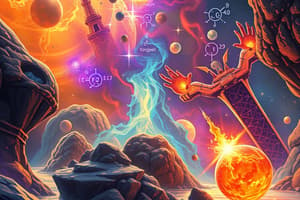Podcast
Questions and Answers
Which of the following correctly describes the Law of Conservation of Matter?
Which of the following correctly describes the Law of Conservation of Matter?
- Matter increases in mass during a chemical reaction.
- Matter can be transformed into energy and vice versa.
- Matter cannot be created or destroyed in a chemical reaction. (correct)
- Matter combines in fixed proportions regardless of the reaction.
What is the purpose of using indicators in acid-base reactions?
What is the purpose of using indicators in acid-base reactions?
- To measure the temperature change in the reaction.
- To identify the pH level of the solution. (correct)
- To balance the chemical equations correctly.
- To determine the states of the reactants and products.
Which method of heat transfer does NOT involve the movement of particles?
Which method of heat transfer does NOT involve the movement of particles?
- Convection
- Insulation
- Conduction
- Radiation (correct)
Which statement best describes the relationship between the independent variable and dependent variable in a graph?
Which statement best describes the relationship between the independent variable and dependent variable in a graph?
What is the primary cause of ocean acidification?
What is the primary cause of ocean acidification?
Flashcards
Law of Conservation of Matter
Law of Conservation of Matter
Matter cannot be created or destroyed in a chemical reaction, only rearranged.
Reactants and Products
Reactants and Products
Reactants are substances that enter a chemical reaction, products are the substances formed.
Independent Variable
Independent Variable
The variable that is changed by the researcher in an experiment.
Dependent Variable
Dependent Variable
Signup and view all the flashcards
Conduction
Conduction
Signup and view all the flashcards
Study Notes
Chemistry
- Law of Conservation of matter
- Word equations and chemical equations
- Reactants and products
- Balancing equations
- States of reactants and products (solid, liquid, gas, aqueous)
- Acids and bases - identification and uses
- Indicators
- pH scale
- Acid-base reactions
- Tests for hydrogen gas and carbon dioxide gas
- Acid rain
- Ocean acidification
Physics
- Heat transfer (conduction, convection, radiation)
- Insulators
- Light - wave and electromagnetic spectrum
- Reflection
- Refraction
- Light interaction with mirrors (plane, convex, concave)
- Light interaction with lenses (convex, concave)
- Light and colour (absorbed, reflected, transmitted wavelengths)
- Light filters (absorbed and transmitted wavelengths)
Scientific Skills
- Understanding science as a human endeavor
- Independent and dependent variables
- Graph analysis (determining trends, interpreting X and Y axis data)
- Scientific process analysis
- Evaluation of results (improving validity)
- Precision (reducing random errors)
- Accuracy (reducing systematic errors)
- Drawing conclusions from data
Studying That Suits You
Use AI to generate personalized quizzes and flashcards to suit your learning preferences.
Related Documents
Description
Test your understanding of key concepts in chemistry and physics. This quiz covers the law of conservation of matter, balancing chemical equations, heat transfer, light properties, and scientific skills such as graph analysis and evaluation of results. Challenge yourself with questions on acids, bases, and the electromagnetic spectrum.




